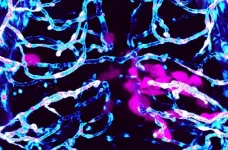(Press-News.org) Knowledge on how cells communicate is an important key to understanding many biological systems and diseases. A research team led by researchers at the University of Gothenburg has now used a unique combination of methods to map the mechanism behind cellular communication. Their findings can potentially improve understanding of the underlying mechanism behind type 2 diabetes.
We know that human communication is important, but communication between the cells in our bodies is just as vital. The processes where cells synchronize and coordinate their behaviour is required for an organism to function and for human organs to be able to perform their functions.
"How do cells go from monologues to dialogues? How do cells transit from acting as individuals to acting as a community? We need to better understand this complex and difficult-to-study behaviour," says Caroline Beck Adiels, senior lecturer at the Department of Physics at the University of Gothenburg.
Have found the mechanism behind cellular communication
She is responsible for the study now published in the scientific journal PNAS, in which the researchers established a method for studying cellular communication. In the study, they successfully mapped the mechanism behind cellular communication in the metabolic process, using small culture chambers that allow the control of the environment around the cells.
The researchers chose to study yeast cells, since they are similar to human cells, and their focus is on glycolytic oscillations - a series of chemical reactions during metabolism where the concentration of substances can pulse or oscillate. The study showed how cells that initially oscillated independent of each other shifted to being more synchronized, creating partially synchronized populations of cells.
"One of the unique things with this study is that we have been able to study individual cells instead of simply entire cell populations. This has allowed us to really be able to see how the cells transition from their individual behaviour to coordinating with their neighbours. We have been able to map their behaviour both temporally and spatially, that is to say, when something occurs and in which cell," says Beck Adiels.
Opens up opportunities for understanding type 2 diabetes
According to Beck Adiels, this knowledge can be applied in many other biological systems and more complex cells where coordinated cell behaviour plays an important role. This type of behaviour is also found in cells such as heart muscle cells and in pancreatic cells, which can be an important piece of the puzzle in diabetes research.
"The study can contribute to understanding how pancreatic cells are regulated and how they secrete insulin, which can help us understand the underlying mechanism behind type 2 diabetes. Eventually, this could contribute to developing new medicines for treating the disease."
The study is a collaboration between eight researchers at Swedish and international universities, and Caroline Beck Adiels emphasizes that this interdisciplinary collaboration has been fundamental in studying the complex behaviour of cells from multiple perspectives.
"I am very proud of this work, which had not been possible to complete if we had not collaborated across disciplines," she says.
INFORMATION:
Text: Ulrika Ernström
The study's title: Intercellular communication induces glycolytic synchronization waves between individually oscillating cells
Digital publication: https://www.pnas.org/content/118/6/e2010075118
Scientific journal: PNAS, Proceedings of the National Academy of Sciences of the United States of America
Co-authors: Martin Mojica-Benavides, David D. van Niekerk, Mite Mijalkov, Jacky L. Snoep, Bernhard Mehlig, Giovanni Volpe, Mattias Goksör and Caroline B. Adiels
Facts about the research and methodology
The researchers mapped the mechanism behind cellular communication in the metabolic process. Yeast cells were chosen since they have many similarities to human cells and can be used as a model organism.
By using small culture chambers (a microfluidic device), yeast cells can be studied under the microscope while controlling the environment around them. The chamber can be designed so the cells are in a single layer, allowing them to be studied individually.
Thanks to one of the substances in the metabolic chain being autofluorescent, i.e., it emits a weak glow when the cell is illuminated at a specific wavelength, the researchers can see how the cells communicate and synchronize.
The experimental results have been verified with a detailed mathematical model of the glycolytic reactions, which has been applied to each individual cell. Software has also been developed from the ground up to study the brain's various connections. This was used to confirm both experimental and theoretical data, but it also provides the researchers a tool to stage several situations of complex cellular communication.
Scientists at the Fralin Biomedical Research Institute at VTC have identified a new zebrafish model that could help advance glioblastoma multiforme research. Glioblastoma is an aggressive form of primary brain tumor - fewer than one in 20 patients survive five years after diagnosis.
The research team previously discovered that human-derived brain cancer cells in mice use the brain's blood vessels like highways to spread away from the original mass. In the new study, published in ACS Pharmacology and Translational Science, they show clear cross-over between mammals and fish and describe similar observations in zebrafish.
"Our hope is that this new work in zebrafish will help researchers ...
COLUMBUS, Ohio - On the outskirts of some small Indigenous communities in the Mexican state of Oaxaca, a few volunteer guards keep watch along roads blocked by makeshift barricades of chains, stones and wood.
The invader they are trying to stop is COVID-19.
For many of Mexico's Indigenous people, poor and ignored by state and federal governments, the fight against the COVID-19 pandemic is one that rests primarily with themselves, said Jeffrey Cohen, a professor of anthropology at The Ohio State University.
That means they must take steps like limiting access to their villages.
"Most of these communities only have ...
peer review/experimental study/animals/cells
Researchers from Uppsala University show in a new study that inhibition of the protein EZH2 can reduce the growth of cancer cells in the blood cancer multiple myeloma. The reduction is caused by changes in the cancer cells' metabolism. These changes can be used as markers to discriminate whether a patient would respond to treatment by EZH2 inhibition. The study has been published in the journal Cell Death & Disease.
Multiple myeloma is a type of blood cancer where immune cells grow in an uncontrolled way in the bone marrow. The disease is very difficult to treat and is still considered incurable, and thus it is urgent to identify new therapeutic targets in the cancer cells.
The research group behind ...
TROY, N.Y. -- An antioxidant found in green tea may increase levels of p53, a natural anti-cancer protein, known as the "guardian of the genome" for its ability to repair DNA damage or destroy cancerous cells. Published today in Nature Communications, a study of the direct interaction between p53 and the green tea compound, epigallocatechin gallate (EGCG), points to a new target for cancer drug discovery.
"Both p53 and EGCG molecules are extremely interesting. Mutations in p53 are found in over 50% of human cancer, while EGCG is the major anti-oxidant in green tea, a popular beverage worldwide," said END ...
DURHAM, N.C. -- Humans aren't the only mammals that form long-term bonds with a single, special mate -- some bats, wolves, beavers, foxes and other animals do, too. But new research suggests the brain circuitry that makes love last in some species may not be the same in others.
The study, appearing Feb. 12 in the journal Scientific Reports, compares monogamous and promiscuous species within a closely related group of lemurs, distant primate cousins of humans from the island Madagascar.
Red-bellied lemurs and mongoose lemurs are among the few species in the lemur family tree in which male-female partners stick together year after year, working together to raise their young and defend their territory.
Once bonded, pairs spend much of their waking hours grooming ...
Every year around 20 Australian children die from the incurable brain tumour, Diffuse Intrinsic Pontine Glioma (DIPG). The average age of diagnosis for DIPG is just seven years. There are no effective treatments, and almost all children die from the disease, usually within one year of diagnosis.
A paper published today 12 Feb 2021 in the prestigious journal, Nature Communications, reveals a potential revolutionary drug combination that - in animal studies and in world first 3D models of the tumour - is "spectacularly effective in eradicating the cancer cells," according to lead researcher and paediatric oncologist Associate Professor David Ziegler, from the Children's Cancer Institute and Sydney Children's Hospital.
In ...
Children treated for cancer with approaches such as chemotherapy can develop therapy-related myeloid neoplasms (a second type of cancer) with a dismal prognosis. Scientists at St. Jude Children's Research Hospital have characterized the genomic abnormalities of 84 such myeloid neoplasms, with potential implications for early interventions to stop the disease. A paper detailing the work was published today in Nature Communications.
The somatic (cancer) and germline (inherited) genomic alterations that drive therapy-related myeloid neoplasms in children have not been comprehensively ...
(Friday, February 12, 2021 - Toronto) -- Inhibiting a key enzyme that controls a large network of proteins important in cell division and growth paves the way for a new class of drugs that could stop glioblastoma, a deadly brain cancer, from growing.
Researchers at Princess Margaret Cancer Centre, the Hospital for Sick Children (SickKids) and University of Toronto, showed that chemically inhibiting the enzyme PRMT5 can suppress the growth of glioblastoma cells.
The inhibition of PRMT5 led to cell senescence, similar to what happens to cells during aging when cells lose the ability to divide and grow. Cellular senescence can also be a powerful tumour suppression mechanism, stopping ...
Space: the final frontier. What's stopping us from exploring it? Well, lots of things, but one of the major issues is space radiation, and the effects it can have on astronaut health during long voyages. A new review in the open-access journal END ...
Research over the last 20 years has shown that atherosclerosis is a chronic inflammatory condition of the arterial blood vessel wall. Soluble mediators such as cytokines and chemokines are pivotal players in this disease, promoting vascular inflammation. However, the development of anti-inflammatory therapeutics directed against such mediators that could prevent atherosclerosis has proven difficult, despite promising clinical studies in the recent past.
Previous anti-inflammatory therapeutic strategies to prevent atherosclerosis, heart attacks, strokes, rheumatoid arthritis and other inflammatory diseases have mainly been based ...






